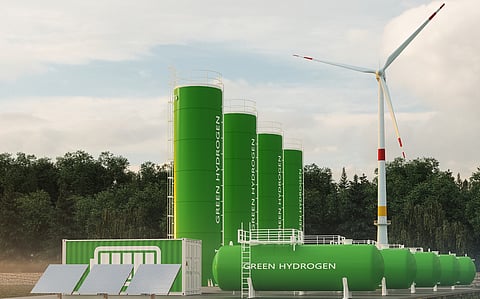Green hydrogen is the missing link in India’s net-zero transition
As the world races to address the climate crisis, green hydrogen emerges as both a promising solution and a potential disruptor in the clean energy landscape. Unlike conventional hydrogen derived from fossil fuels, green hydrogen is produced using renewable energy sources and emits zero carbon in the process. For India—committed to achieving net-zero emissions by 2070—green hydrogen is not merely an opportunity; it is a necessity.
Why green hydrogen matters
Green hydrogen, produced using renewable electricity through electrolysis, is gaining global attention as a versatile and zero-emission fuel. Unlike grey hydrogen derived from fossil fuels, green hydrogen offers a clean energy alternative that can be applied across diverse sectors—transportation, industry, and power. It acts as both a fuel and an energy carrier, capable of stabilising grids by storing excess renewable power and meeting peak demand. More importantly, it plays a pivotal role in decarbonising “hard-to-abate” industries such as steel, cement, ammonia, and long-haul transport, where direct electrification is impractical or costly. For a developing country like India, green hydrogen is not just a technological opportunity—it is an essential enabler for sustainable growth. It bridges the gap between the present carbon-intensive infrastructure and a future powered by renewables. By integrating green hydrogen, India can balance economic development with environmental goals, making strides toward its 2070 net-zero target. The adoption of green hydrogen also offers energy security, reducing dependency on imported fossil fuels. As climate change intensifies, India must embrace green hydrogen as a strategic solution—both to meet its international climate commitments and to transition into a resilient, clean-energy economy.
For India, green hydrogen offers a pathway to reconcile economic development with environmental stewardship.
A bold beginning
India’s National Green Hydrogen Mission, launched in January 2023 with Rs 19,744 crore, aims to produce 5 million metric tonnes (MMT) of green hydrogen annually by 2030. The initiative supports over 125 GW of renewable energy and could reduce 50 MMT of CO2 per year while creating 600,000 jobs. Financial support under the SIGHT program and pilot projects in steel and shipping show India’s intent to lead in green hydrogen. These steps aim to align clean energy goals with national development..
To drive this mission, the Strategic Interventions for Green Hydrogen Transition (SIGHT) program offers financial incentives—Rs 17,490 crore to support production and electrolyser manufacturing. Pilot projects in sectors like shipping and steel are already underway, including plans to retrofit vessels and develop green ammonia refuelling hubs at key ports. These are not just technical experiments; they are strategic moves to anchor India’s place in the global hydrogen economy.
India’s renewable advantage
India’s vast solar and wind resources provide a strong base for green hydrogen production. With 180 GW of renewable energy already installed and a 2030 target of 500 GW, India can produce green hydrogen affordably. Large corporations like Reliance and Adani plan major investments, potentially increasing production beyond the government’s targets. These efforts support India’s climate goals under the Paris Agreement, helping reduce carbon intensity and dependence on coal.
Green hydrogen could become the cornerstone of India’s clean energy strategy, combining low costs with global competitiveness.
Staying competitive in a global race
Green hydrogen costs currently range between $2.7-8.8/kg but are expected to fall to $2-6/kg by 2030. Countries like China are scaling fast, lowering global costs through technology and manufacturing dominance. India must stay competitive by expanding domestic electrolyser production, building full hydrogen value chains, and forming strategic partnerships. Government incentives—such as capital subsidies and tariff waivers—could help green hydrogen reach parity with fossil-based alternatives. With coordinated efforts, India can be a leader in the global hydrogen economy.
To stay competitive, India must act swiftly and strategically. Building robust domestic manufacturing capabilities is crucial—not just for electrolysers but for the entire green hydrogen value chain. India must also actively engage in global partnerships, secure access to critical minerals, and create a business environment that attracts both domestic and foreign investment.
Overcoming key challenges
India faces several hurdles—high capital costs, raw material dependence, safety issues, and limited infrastructure for hydrogen transport and storage. Financing is another major concern, especially in emerging markets. Innovative funding models and policy support are needed to attract investments. Environmental oversight is also essential, as hydrogen could indirectly affect greenhouse gases like methane and ozone. India must ensure robust monitoring to maintain its green credentials. Overcoming these issues is key to unlocking the full potential of green hydrogen.
Environmental safeguards also need to evolve. Though hydrogen is a clean fuel, it can indirectly impact greenhouse gas levels by affecting methane and ozone concentrations. India must therefore adopt strong monitoring and regulatory mechanisms to ensure that green hydrogen truly remains green.
A call to action
The National Green Hydrogen Mission is a strong first step, but India must adopt a whole-of-economy approach to scale its efforts. Integrating green hydrogen into national policies, trade strategies, and urban planning is crucial. International partnerships, such as with the EU, can support technology transfer and market access. India has a unique chance to lead the global green hydrogen movement. But quick action, bold investments, and strategic planning are needed to ensure long-term success and global leadership in clean energy.
India has a window of opportunity to lead the world in green hydrogen—but this window will not stay open forever. With bold leadership, targeted investments, and strategic global engagement, India can position itself as a clean energy powerhouse, proving that climate responsibility and economic ambition can go hand in hand.
Anushka Bandyopadhyay and Raktimava Bose is associated with National Council of Applied Economic Research (NCAER) and Debanka Samanta is associated with The Energy and Resources Institute (TERI)
Views expressed are author's own and don't necessarily reflect those of Down To Earth

